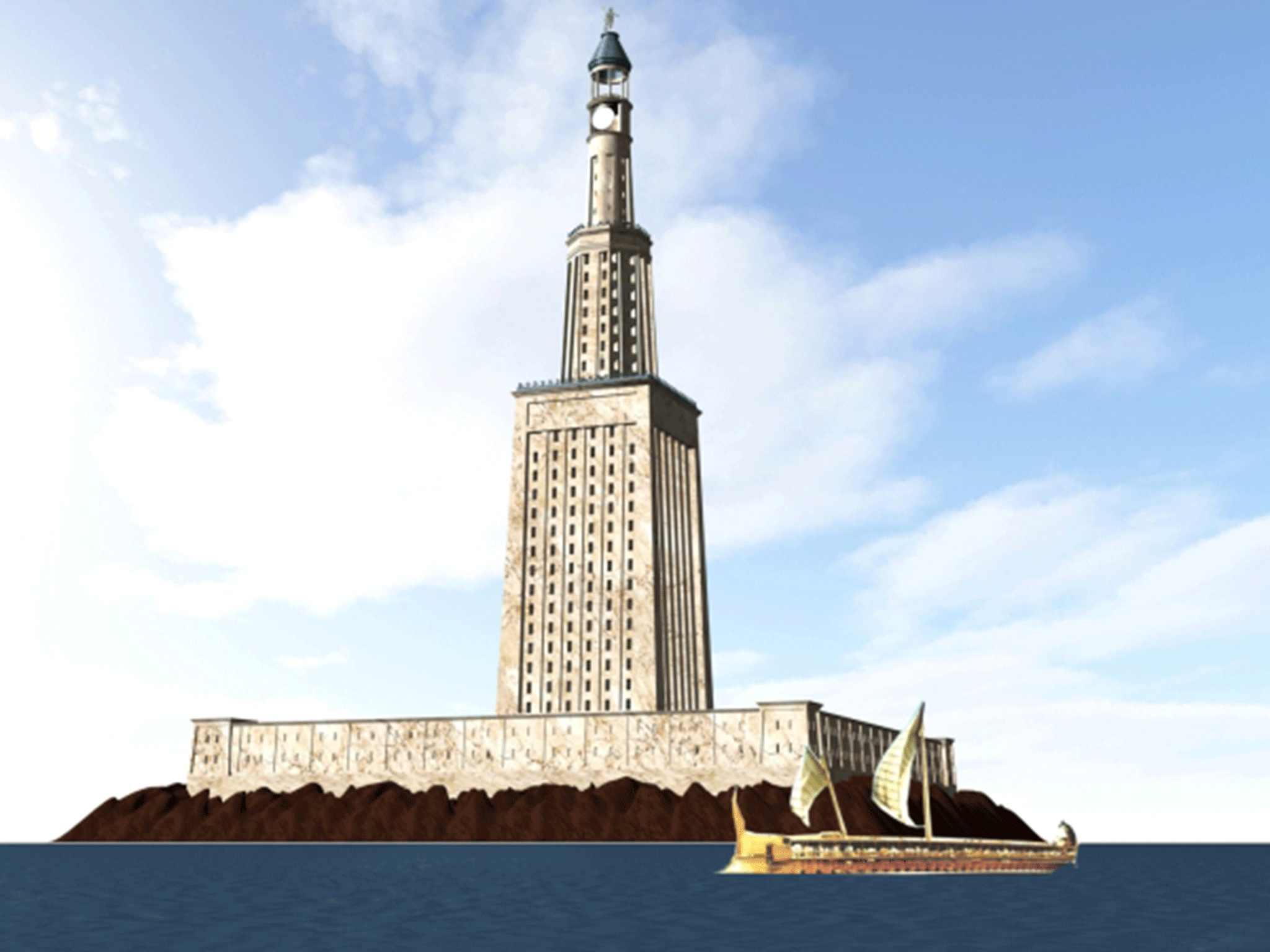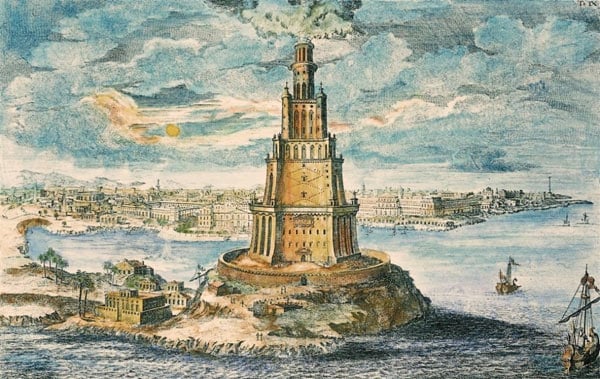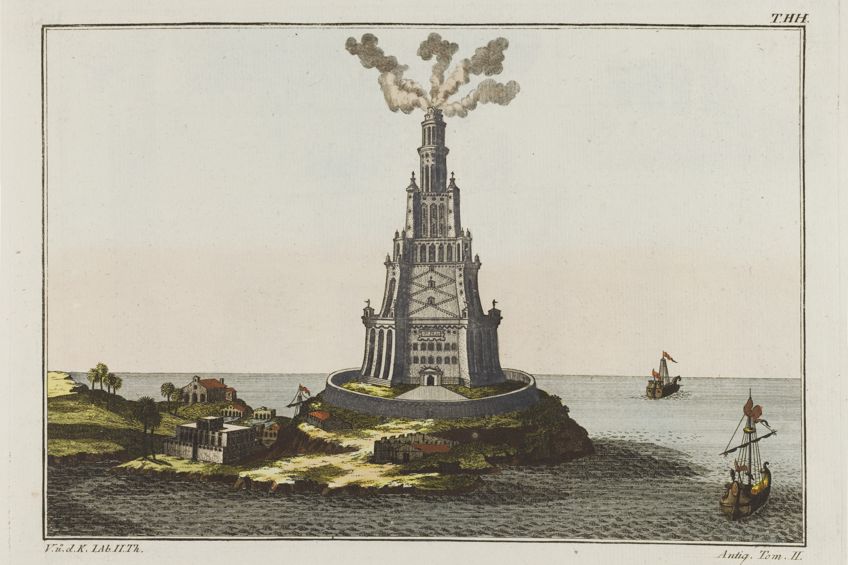THE LIGHTHOUSE OF ALEXANDRIA

The Lighthouse of Alexandria, also known as the Pharos of Alexandria, is perhaps one of the most fascinating architectural marvels in the ancient world. Located on the island of Pharos, off the coast of Alexandria, Egypt, this historic structure served as a crucial navigational aid for sailors in the Mediterranean Sea. Let's delve deeper into the historical significance of the Lighthouse of Alexandria and explore its intriguing features.
The Lighthouse of Alexandria: An Ancient Architectural Marvel
Constructed in the 3rd century BC, the Lighthouse of Alexandria was commissioned by Ptolemy I Soter, one of the generals of Alexander the Great. It stood over 100 meters tall, making it one of the tallest man-made structures of its time. Ancient accounts describe its construction as a combination of limestone blocks and smooth white marble, giving it an elegant and grand appearance.
The lighthouse was designed by Sostratus of Cnidus, a renowned architect and engineer. Its innovative architectural design included three main sections: a rectangular base, a tapering cylindrical shaft, and a circular platform with a statue of the Greek god Poseidon or Zeus on top.
One of the most remarkable features of the lighthouse was its revolutionary use of mirrors and fires to produce a powerful beam of light. Historians believe that the light was produced by a furnace at the top of the tower, which would emit a controlled flame. Mirrors were strategically placed around the flame to reflect and amplify the light, providing a guiding beacon for ships.
The Historical Significance of the Lighthouse of Alexandria
The Lighthouse of Alexandria played a vital role in ensuring the safety of ships navigating the treacherous waters of the Mediterranean Sea. Its strategic location made it an essential landmark for sailors, providing them with a reliable reference point to determine their position and navigate their journeys.
In addition to its navigational purpose, the lighthouse also served as a symbol of the power and wealth of Alexandria. It became an iconic symbol of the ancient world and was considered one of the Seven Wonders of the Ancient World.
Unfortunately, the Lighthouse of Alexandria no longer stands today. It suffered several damages from earthquakes over the centuries, and by the 14th century AD, it had largely disappeared. However, its historical significance and architectural innovations continue to captivate the imagination of people around the world.
The Lighthouse of Alexandria is a testament to ancient engineering and represents the rich maritime history of the Mediterranean region. Its architectural marvels and navigational importance continue to inspire awe and intrigue, reminding us of the advancements made by our ancestors in shaping the world we inhabit today.

Architecture and Design
The Lighthouse of Alexandria, also known as the Pharos of Alexandria, is an architectural wonder of the ancient world. This magnificent structure was located on the island of Pharos, just off the coast of Alexandria, Egypt. Let's take a closer look at the architecture and design of this historic landmark.
Overview of the Lighthouse of Alexandria's Structure
The Lighthouse of Alexandria was commissioned by Ptolemy I Soter, a general of Alexander the Great, in the 3rd century BC. It stood over 100 meters tall, making it one of the tallest man-made structures of its time. The lighthouse consisted of three main sections: a rectangular base, a tapering cylindrical shaft, and a circular platform with a statue of the Greek god Poseidon or Zeus on top.
The lighthouse's base was rectangular and provided a solid foundation for the structure. The cylindrical shaft rose from the base and gradually tapered towards the top. This design allowed for stability and resistance against the strong winds and earthquakes that were common in the region. The circular platform at the top housed the statue and served as a lookout point for the lighthouse operators.
Construction Materials and Techniques Used in the Lighthouse of Alexandria
The Lighthouse of Alexandria was constructed using a combination of limestone blocks and smooth white marble. These materials gave the lighthouse an elegant and grand appearance, showcasing the architectural expertise of the time. The limestone provided strength and durability, while the marble added a touch of sophistication.
One of the most remarkable features of the lighthouse was its innovative use of mirrors and fires to produce a powerful beam of light. At the top of the tower, a furnace was used to produce a controlled flame. Mirrors were placed around the flame to reflect and amplify the light, creating a guiding beacon for ships navigating the Mediterranean Sea.
The construction techniques used in the Lighthouse of Alexandria were advanced. Skilled architects and engineers, such as Sostratus of Cnidus, were responsible for its design and construction. Their expertise in structural stability and using materials ensured the longevity of the lighthouse.
The Lighthouse of Alexandria was a marvel of ancient architecture and design. Its impressive height, solid structure, and innovative use of mirrors and fires made it an essential navigational aid for sailors in the Mediterranean Sea. The combination of limestone and marble materials showcased the craftsmanship of the era. Although it no longer stands today, the Lighthouse of Alexandria continues to inspire awe and admiration for the advancements made by our ancient ancestors in shaping the world we know today.

Function and Purpose
The Lighthouse of Alexandria, also known as the Pharos of Alexandria, served various functions and played a crucial role in ancient maritime navigation. Beyond its primary function of guiding ships safely to the harbour, the lighthouse had a significant impact on knowledge and culture at the time.
The Role of the Lighthouse of Alexandria in Maritime Navigation
The main purpose of the Lighthouse of Alexandria was to provide a beacon of light that would assist sailors in navigating the treacherous waters of the Mediterranean Sea. Its towering height of over 100 meters made it visible from miles away, ensuring that ships could easily identify the location of the harbour.
The lighthouse's innovative use of mirrors and fires created a powerful beam of light that could guide ships during the night. The controlled flame at the top of the tower, combined with strategically placed mirrors, reflected and amplified the light, creating a guiding beacon for sailors.
This unprecedented use of technology allowed ships to navigate with greater accuracy, reducing the risks of shipwrecks and aiding in the growth of maritime trade in the region. The Lighthouse of Alexandria became a symbol of safety and security for sailors, ensuring their safe arrival and departure from the bustling port.
The Lighthouse of Alexandria as a Beacon of Knowledge and Culture
Beyond its practical role in maritime navigation, the Lighthouse of Alexandria held significant cultural and educational value. The lighthouse stood as a testament to the technological advancements and architectural achievements of the time, showcasing the ingenuity and craftsmanship of the ancient world.
The lighthouse became a symbol of intellectual and cultural prowess, attracting scholars, philosophers, and traders from all over the Mediterranean. The Library of Alexandria, located nearby, further enhanced the city's reputation as a centre of knowledge and learning.
The presence of the lighthouse acted as a magnet for intellectual and cultural exchange. It facilitated the sharing of ideas, the transmission of knowledge, and the growth of various disciplines, including mathematics, astronomy, and geography. The scholars and intellectuals who visited or resided in Alexandria were drawn to the city's vibrant intellectual atmosphere, fostering innovation and advancement in numerous fields.
The Lighthouse of Alexandria played a vital role in maritime navigation, ensuring the safe arrival and departure of ships in the ancient world. Its innovative use of mirrors and fires revolutionized how sailors navigated the treacherous waters. Additionally, the lighthouse became a symbol of knowledge and culture, attracting scholars from far and wide. The legacy of the Lighthouse of Alexandria continues to inspire awe and admiration, standing as a testament to the remarkable achievements of our ancient ancestors.

Historical Significance
The Lighthouse of Alexandria, also known as the Pharos of Alexandria, holds immense historical significance for Ancient Egypt and the Mediterranean world. This iconic structure served as more than just a lighthouse; it symbolized the technological prowess, cultural richness, and maritime dominance of the time.
The Lighthouse of Alexandria's Impact on Ancient Egypt and the Mediterranean World
The construction of the Lighthouse of Alexandria was a testament to the ambitious vision and engineering expertise of the Ptolemaic dynasty. With its towering height and innovative use of mirrors and fires, it revolutionized maritime navigation in the region. Ships from all corners of the Mediterranean relied on its guiding light to safely navigate the treacherous waters and reach the bustling city of Alexandria.
The lighthouse's impact extended beyond the practical realm of navigation. Its presence elevated Alexandria to become one of the greatest cultural and intellectual centers of the ancient world. The lighthouse attracted scholars, philosophers, and traders, creating a vibrant hub of knowledge and exchange. The nearby Library of Alexandria added to the city's reputation as a haven for education and learning, further solidifying its position as a beacon of intellectual prowess.
Demise and Legacy of the Lighthouse of Alexandria
Sadly, the magnificent Lighthouse of Alexandria met its demise over the centuries due to various natural disasters and human activities. Earthquakes and erosion gradually deteriorated its structure, and the final blow came with an earthquake in the 14th century, reducing the once-mighty lighthouse to ruins.
However, despite its physical disappearance, the legacy of the Lighthouse of Alexandria continues to inspire awe and admiration. Its impact on maritime navigation, architectural innovation, and intellectual exchange cannot be understated. The lighthouse stands as a testament to the remarkable achievements of our ancient ancestors and serves as a reminder of the rich history and heritage of the Mediterranean world.
Today, the lighthouse's legacy lives on through numerous replicas, artistic interpretations, and references in literature and popular culture. It continues to captivate the imagination and curiosity of people worldwide, drawing them to explore the mysteries and grandeur of the ancient world.
The Lighthouse of Alexandria was pivotal in shaping the history and culture of Ancient Egypt and the Mediterranean world. Its impact on maritime navigation and intellectual exchange was unparalleled, and its demise has only strengthened its legacy. As we marvel at the remnants of this iconic structure, we are reminded of the ingenuity, innovation, and rich history of our ancient ancestors.

Rediscovery and Preservation Efforts
Uncovering the Ruins: Archaeological Discoveries of the Lighthouse of Alexandria
Rediscovering the Lighthouse of Alexandria, also known as the Pharos of Alexandria, is a fascinating tale of archaeological endeavours. For centuries, its location remained a mystery until, in 1994, a team of divers stumbled upon the remains of this ancient wonder. Excavations have since uncovered various parts of the lighthouse, giving us a glimpse into its grandeur and engineering marvels.
Underwater investigations have revealed sections of the foundational stones, as well as fragments of statues and decorative elements that once adorned the structure. These findings have allowed researchers to piece together the lighthouse's original design and gain insights into its construction techniques.
Furthermore, excavating the nearby underwater ruins has provided valuable information about the layout and significance of the entire area surrounding the lighthouse. It has unearthed remnants of an ancient shipyard and harbour, offering a deeper understanding of Alexandria's maritime history.
Preserving the Lighthouse of Alexandria's Legacy for Future Generations
Preserving the legacy of the Lighthouse of Alexandria is paramount to ensure that future generations can appreciate its historical significance. Efforts are underway to protect the remaining ruins and raise awareness about this iconic structure.
One such initiative is the establishment of the Lighthouse of Alexandria Archaeological Park. This park serves as a platform for visitors to learn about the history and significance of the lighthouse through informative displays and interactive exhibits. It also provides a space for ongoing research and further excavations.
In addition to physical preservation, digital technologies play a crucial role in documenting and conserving the lighthouse's legacy. Digitization efforts capture detailed 3D models of the ruins, enabling virtual reconstructions and immersive experiences that transport visitors back in time. These digital replicas help to preserve the memory of the lighthouse and make it accessible to a global audience.
Furthermore, collaborations between international organizations and local authorities aim to raise funds to restore the lighthouse's remaining structures. Through carefully planned restoration projects, the goal is to stabilize and conserve the ruins, ensuring their survival for future generations.
The rediscovery and ongoing preservation efforts of the Lighthouse of Alexandria are vital in keeping its legacy alive. By uncovering its secrets and sharing its story with the world, we honour the achievements of our ancient ancestors and inspire future generations to appreciate and cherish the wonders of our shared human history.
Frequently Asked Questions about the Lighthouse of Alexandria
Q: Where is the Lighthouse of Alexandria located?
A: The Lighthouse of Alexandria was located on the island of Pharos, near the ancient city of Alexandria in Egypt.
Q: When was the Lighthouse of Alexandria built?
A: The Lighthouse of Alexandria was constructed in the third century BC, around 280 BC, during the reign of Ptolemy II.
Q: How tall was the Lighthouse of Alexandria?A: The exact height of the Lighthouse of Alexandria is unknown, but it is believed to have been around 393 feet (120 meters) tall, making it one of the tallest man-made structures of the ancient world.
Q: What was the purpose of the Lighthouse of Alexandria?A: The Lighthouse of Alexandria served as a navigational aid for ships entering the harbour of Alexandria. It emitted a bright light at night, guiding sailors safely to port.
Q: What happened to the Lighthouse of Alexandria?A: The Lighthouse of Alexandria was severely damaged by earthquakes in the 14th century AD. Over time, the remaining ruins were further destroyed, and today, only a few fragments of the lighthouse remain.
